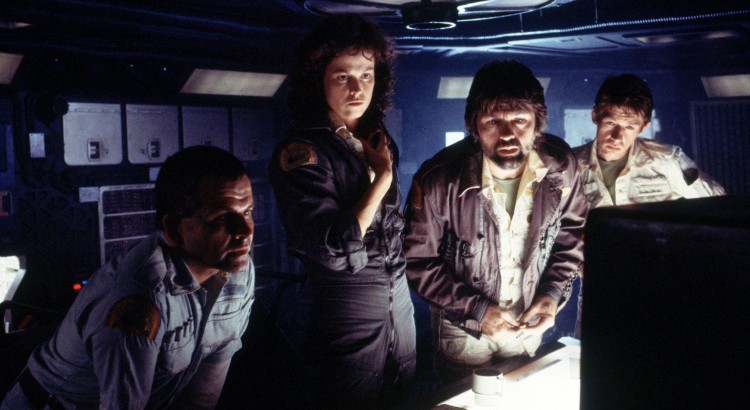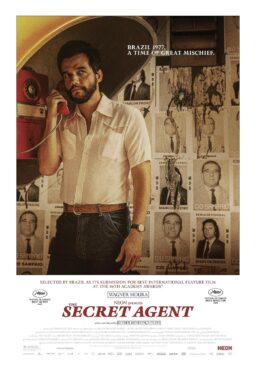I’ve seen “Alien” more times than I can count, and not only has it lost any possibility of surprising me in terms of narrative, you could probably say that there isn’t a frame of that thing that I haven’t studied every inch of. So why do I keep going back? Why do I watch it on cable and on video and sometimes streaming even though I own the disc? Why do I go to theatres when they’re having repertory screenings? It’s because of the sheer, staggering beauty of this object that Ridley Scott and Dan O’Bannon, his screenwriter, and his production designers, particularly H.R. Giger and Ron Cobb, created.
I watched it again very recently with a couple of my kids and I was struck once again by the sheer level of detail and thoughtfulness that was put into every composition. The way that the camera moves to reveal the interior of the Nostromo; the way that Ridley Scott has the members of the crew waking up in a series of dissolves, as if they’re one organic being all connected; the way that the surface of LV-426, the planet that they are exploring and that isn’t really named until the sequel, looks like it’s made out of torn pieces of construction paper or cardboard—not a real place, but a storybook place.
I love the difference in texture between the heavy-duty mechanical portions of the ship and spaces like the control room where the crew members go to speak to “Mother,” this film’s equivalent of the HAL 9000 computer. It’s white and it’s got little sparkly lights, a very feminine sort of design in comparison with the rest of the ship—but it’s also a padded room, the kind of place where you would put someone who had lost their mind and was in danger of harming themselves.
And what is it that drives the crew and the viewer crazy in this movie? It’s the perversion of the biology that we know. The Xenomorph is a combination of phallic and vaginal signifiers of menace. Its head is a giant, serrated dildo and a vagina at the same time, and it’s got long, elegant, almost womanly fingernails and the powerful back of an old-time dock worker who spends his life lifting crates with hooks. Plus, spines coming out of the back, and you have no idea what those things are for—these things that look like chunks of a giant parasite, like something that would be surgically removed from someone’s body. This creature exists to kill and violate. It’s one of the most scary monsters in the history of movies. It just looks obscene.
The structure of the film is so traditional that there’s something almost comforting about it. It was described at the time that it came out as “a slasher movie set in outer space,” and that’s 100% accurate. It was made in the same decade as “Halloween,” and it came out a year before “Friday the 13th” and a few years before “A Nightmare on Elm Street” and “The Terminator,” and it’s definitely another “unstoppable killer” movie. But it’s the design and the lighting and the direction and the overall mood that elevates it beyond the ordinary.
It’s also remarkable how much life the actors put into these parts. Every person in that crew seems real, even though if you look at their dialogue on the page, they don’t really have a lot and it’s not that memorable. It’s very much them spelling out their relationships to each other and to the ship, but from the second that Harry Dean Stanton and Yaphet Kotto’s characters, Brett and Parker, start wearily bantering at the breakfast table, you know that these guys have been friends since forever, and they’ve got this working-stiff energy. And you can see that they are at odds with Sigourney Weaver’s Ripley, with her laser-focused eyes and finishing school accent, and Ian Holm’s ship’s officer Ash with his British accent and fussy mannerisms and lack of anything resembling charm.
Contrast him with the other Englishman in the cast, Kane, played by John Hurt. He seems almost bereft of anything resembling a negative feeling. He’s a nice guy; he’s there to be sacrificed, and he has that classic pale, gaunt English face you see in photographs from WWI. Veronica Cartwright’s character, Lambert, wasn’t put on earth to deal with situations like this and she crumbles almost immediately. This is not what she signed up for.
Tom Skerrit’s character, Captain Dallas, doesn’t have a back story (like everyone else) but the one I’ve invented for him in my head is that he was a worker, a blue collar guy, who got the chance to be promoted into management and took it. He probably has instinctive feelings of sympathy for the working people on the ship but he’s required to think about the needs of the company first, and that delicate negotiating act is beautifully portrayed. He really listens to the crew, he doesn’t seem to be faking it, he mirrors their emotions in a sincere way and he probably comes the closest to seeming like a classic movie hero. And of course, he dies a horrible, anti-climactic death in the tunnel. That’s when hope is extinguished from the movie, because ordinarily the calm, soft-spoken, fortysomething white guy is the person who’d make it all the way to the end of a Hollywood movie and blow the alien out the airlock. Killing Dallas midway through is like killing off the person you think is the hero 40 minutes into “Psycho”.
All of these characters have a great deal of difficulty coming to grips with the situation they’re trapped in and taking appropriate action, and that’s the most humanizing thing about “Alien.” If you and I were on that ship under those circumstances, would we handle things better? Would we do things correctly? I’m sure we wouldn’t. We think we’d act like Ripley, but we’d probably act more like Lambert.
The last 40 minutes of this movie really can’t be improved in any significant way: they’re perfect. It just become this third act of “a symphony of horror” (to quote F.W. Murnau), and by the time Ripley is setting the ship to self-destruct while the Xenomorph is making a meal of the remaining crewmembers and the lights are flashing and the noises are blaring, it becomes unrelenting. You all want that release of knowing the story is over and they all lived happily ever after, and Ridley Scott keeps denying it. Even the final shot of Ripley in her suspended animation chamber like Sleeping Beauty is charged with menace because you’ve seen what this alien can do, and you’re not entirely sure that there isn’t something else on board.
In fact, if you sit all the way through to the credits, when you get to the very end and Jerry Goldsmith’s score peters out, you hear a splat noise that sounds like an egg hatching.












